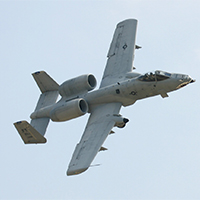End looms for US Air Force’s A-10

Long disliked by the US Air Force, the A-10 Thunderbolt II ground-attack jet may finally be heading for the chopping block due to budget constraints.
The “Warthog,” first designed as a tank buster to target Soviet armored vehicles in the middle of the Cold War in the early 1970s, is shunned by many aviators.
Although the twin-engine aircraft is slow, it is incredibly efficient at providing close air support for ground forces, making it an appreciated asset for the US Army.
But the US Air Force “never had a whole lot of interest in a subsonic close-air support plane,” explained Richard Aboulafia, an aerospace analyst with consulting firm Teal Group.
“This is a plane for large land combat engagements and for the foreseeable future, you probably won’t face too many of those and there’s also the budget pressure.”
The US Air Force had tried several times since the end of the Cold War to scrap a large part of its A-10 fleet but then gave up in the face of a series of unexpected deployments such as the Gulf War and the conflicts in Iraq and Afghanistan.
“Just because they’ve had this long-standing dislike for the A-10 doesn’t mean that they aren’t right this time,” said Aboulafia.
The Defense Department faces $1 trillion in budget cuts over the next decade, half of them due to automatic reductions in spending known as sequestration.
The US Air Force alone needs to save $12 billion in 2014, according to the service’s Chief of Staff General Mark Welsh.
So by 2015, the Air Force plans to part ways with its entire A-10 fleet — 326 aircraft — hoping to save $3.7 billion in the process.
“It is the best airplane in the world at what it does,” Welsh told lawmakers, noting he had flown the aircraft himself for a “thousand” hours.
But “if we’re going to look at what we must divest, not what we want to divest, but what we must divest, we have to be very honest with ourselves inside the Air Force about how much we can afford,” he added.
The problem with the A-10, which sports a heavy rotary cannon, is that it is limited to its only capacity to support ground missions, a big drawback compared to multi-mission aircraft such as the F-15 or F-16.
“If we have platforms that can do multiple missions well and maybe not do one as well as another airplane, the airplane that is limited to a specific type of mission area becomes the one most at risk,” Welsh said.
“You only gain major savings if you cut an entire fleet.”
Speaking Thursday before the American Enterprise Institute think-tank in Washington, Welsh stressed that to make the same savings of $3.7 billion, “we would have to shut down three to four times as many F-16s squadrons as we do A-10s.”
“If that’s the case, we can’t do the mission,” he added.
The A-10 also only makes less than 30 percent of sorties for close air support missions.
F-16 fighter jets and Apache helicopters currently contribute to such missions and the F-35 — the Pentagon’s main armament program — is due to participate in the future.
“Historical animosity,” however, has seen the Army try to halt the Air Force’s plans, Aboulafia said.
“The A-10 is the best close air support platform we have today,” Welsh’s counterpart in the Army, General Ray Odierno, testified before the Senate Armed Services Committee in November.
“It’s performed incredibly well in Iraq and Afghanistan.”
Three dozen senators and lawmakers from both main parties wrote to Defense Secretary Chuck Hagel last month noting their “deep concern” over plans to scrap the A-10 in their respective states.
“We oppose any effort that would divest the A-10, creating a CAS (close air support) capability gap that would reduce Air Force combat power and unnecessarily endanger our service members in future conflicts,” they wrote.
The letter was led by Senators Kelly Ayotte, Mark Pryor, Saxby Chambliss and Claire McCaskill, along with Representatives Ron Barber and Jack Kingston. It was also signed by nine other senators and 18 other representatives.
Ayotte has proposed an amendment to the 2014 budget law seeking to delay until at least 2022 the A-10 fleet’s retirement.